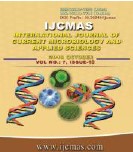


 National Academy of Agricultural Sciences (NAAS)
National Academy of Agricultural Sciences (NAAS)

|
PRINT ISSN : 2319-7692
Online ISSN : 2319-7706 Issues : 12 per year Publisher : Excellent Publishers Email : editorijcmas@gmail.com / submit@ijcmas.com Editor-in-chief: Dr.M.Prakash Index Copernicus ICV 2018: 95.39 NAAS RATING 2020: 5.38 |
Although most earthworms live at or under the surface of the soil, other factors influence their choice of habitat. Two key factors are climate and vegetation. Earthworms tend not to live in exceptionally dry or cold places. The earthworms live in indigenous forests and tussock grassland, while introduced species are most commonly found in cultivated soils such as pasture, croplands and lawns. A more specific way to describe where earthworms live is their niche – the position of the species within its habitat. A species’ niche includes both its physical location and the role it plays within the environment. By occupying a specific niche, earthworms make use of conditions that are best suited to their survival. Although all earthworms have common characteristics, features like size, pigmentation (skin colour) and quickness of movement reflect which niche different species occupy. Soil-dwelling earthworms fall into three main niche groupings: compost and soil-surface dwellers (epigeic), top-soil dwellers (endogeic) and deep-burrowing subsoil dwellers (anecic). The present attempt intends to communicate the importance of earthworm diversity conservation. Development of conservation management to prevent earthworm diversity decline should be done wisely and involve all stakeholders.
 |
 |
 |
 |
 |